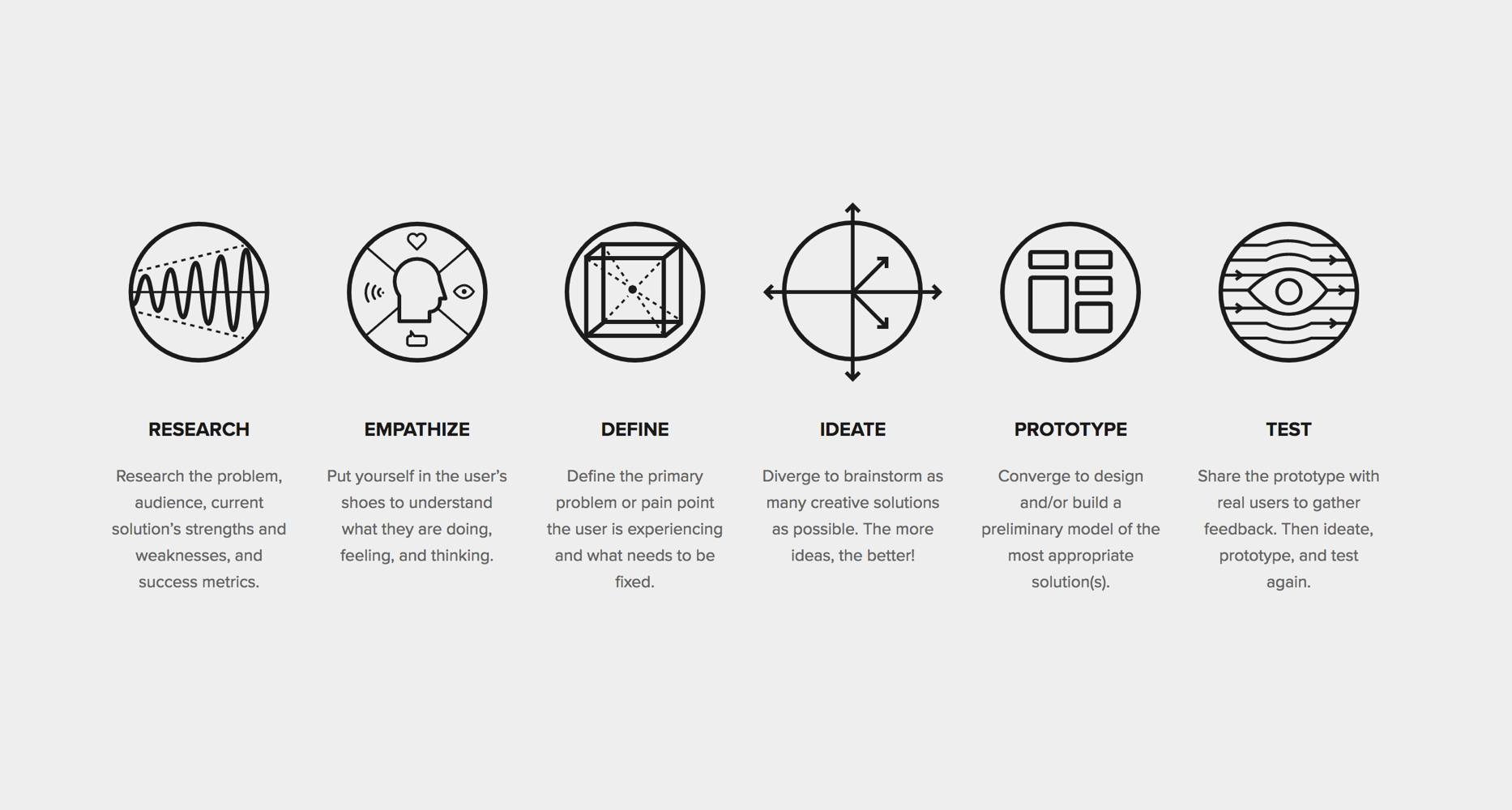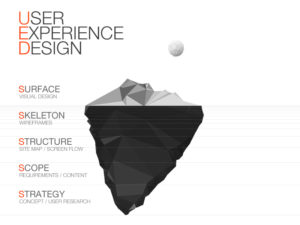The Drawbackwards Design Thinking Process

Shortly after World War II, a new Japanese manufacturing practice emerged that transformed one automobile company into a global leader and inspired millions of businesses ever since.
Factory workers at Toyota began implementing quality circles, a system of continuous, small improvements. Facing scarce resources and high stakes after the war, the company hoped taking these minor steps would add up to major benefits, including faster delivery, less waste, cost savings, and higher customer satisfaction.
This practice, Kaizen, ended up being one of the greatest advancements in Toyota’s history and the entire manufacturing industry. It has become the cornerstone of the Toyota Production System and helped catapult the company to consistent success ever since.
Design Thinking: The Design Industry’s “Kaizen”
What Kaizen was for manufacturing, design thinking is for design and innovation: a systematic process for improvement and problem solving.
Kaizen has helped Toyota not only achieve a greater market capitalization than that of General Motors, Ford, and Honda combined, but also inspired an entire movement. Manufacturing no longer purely focuses on churning out widgets. Now, it’s a methodical process that elicits new ideas and creates a system for continuous improvement – just like design.
Source: Forbes
The idea of design thinking first surfaced in the 1960s and 70s before becoming more popular in the 1980s and 90s thanks to Peter Rowe’s 1987 Design Thinking book, the Stanford University d.school, and Tim Brown, CEO of IDEO. Brown defines design thinking as:
“A human-centered approach to innovation that draws from the designer’s toolkit to integrate the needs of people, the possibilities of technology, and the requirements for business success.”
As Brown describes, design thinking acknowledges that design is no longer pure aesthetics that appeal to personal taste. It’s a critical-thinking process that solves business problems, produces millions (often billions) in ROI, and truly makes a difference in someone’s life.
Aesthetic Design (or “Classical Design”) vs. UX Design (or “Design Thinking”)

This shift from “classical design” to “design thinking” has also sparked a shift in the design process. Instead of being focused on making something look good, the design thinking process focuses on understanding and solving a specific problem to produce positive results.
In the film The Loop, Phil Gilbert, General Manager of Design at IBM, explains:
“The first decision we made [in IBM’s design department] is that we were not going to go around evangelizing design and evangelizing design thinking as anything particularly interesting. The only thing we were going to do was evangelize outcomes delivered to the market that were the result of the practice.
The business doesn’t care about design thinking. The business doesn’t care about any concept. The business only cares about market outcomes. And in order to accelerate the outcomes, we use these practices.”
As Gilbert describes, design thinking isn’t a magical formula, but rather, a practical path to outcomes. It guides people through the steps of empathizing with users and the problem first, then diverging to brainstorm numerous ideas for solutions, and converging to identify the best one.
This methodology also embraces the idea of iteration. Like Kaizen, it acknowledges that the process is never “done” and that there is always room for improvement.
What Kaizen was for manufacturing, design thinking is for design and innovation: a systematic process for improvement and problem solving.
The Drawbackwards Design Thinking Process
Typically, the design thinking process consists of 5 stages: Empathize, Define, Ideate, Prototype, and Test. Following these 5 steps alone can produce meaningful results. However, our team at Drawbackwards has emphasized an initial, separate step of research that “draws backward” first to move forward faster.
Here’s what our process looks like and how it drives even greater ROI.
Research
Empathy is usually the first step in the design thinking process, but our team has found that it’s sometimes too big of a leap to take as the first step, especially for enterprise companies. Before you can empathize with your users, you need to understand who your users are and the constraints that will dictate their solution (business objectives, budget, timeline, etc.).
That’s why we start with research, which helps address several key questions and pain points, such as:
- “What’s the real problem we’re trying to solve?”
- ”What are our business or organizational objectives, and how will solving this problem help achieve those objectives?”
- ”Who is our current target audience and ideal audience? Are there multiple audience segments?”
- ”What are the strengths and weaknesses of our current solution?”
- “How does our leadership feel about the problem at hand, and how do they make decisions?”
- “What are our other constraints, such as timeline and budget?”
- “How will success be measured?”
Only with this context can you truly understand the landscape, how your current solution is working, and how it could be improved.
Empathize
Empathizing is a commonly skipped step in a design process, yet it often makes the biggest difference in producing positive results. Most of us think we know our users, but do our perceptions match reality? Empathizing tests the waters by answering questions like:
- ”What are all the different types of people who use our product or service?”
- ”What makes them tick?”
- ”What are their attitudes about our product/service category in general? What are they looking for?”
- ”What are they thinking, feeling, saying, seeing, and doing on a daily basis?”
- ”How do those senses affect the decisions they make about our product or service?”
Define
Most of us have been taught that real innovation starts from zero and that “thinking outside the box” helps with creative brainstorming. However, people actually need constraints to be creative.
That’s why Define is such an important step. It combines the research and empathy gathered during steps 1 and 2 to define a design philosophy and user stories that address:
- “What’s the problem or pain point the user is experiencing?”
- “What products and solutions do they currently use to solve that problem or pain point?”
- “What are the shortcomings of their current products and solutions?”
- “How will ours be better?”
- “What features should be prioritized for our MVP, and which ones might be added later?”
Rather than thinking outside the box, these questions help understand what the box is so you can identify innovative solutions that will work within it.
Ideate
When companies seek help improving their product, they often ask a designer or consultant to start with the Ideate stage, which involves diverging to brainstorm as many creative solutions as possible. They’re thinking things like:
- “We know what the problem is, but how might we solve it in an innovative way?”
- ”What are some radical ways we could relieve our users’ pains and meet their needs?”
- ”What might the ideal solution look, sound, and feel like?”
- ”How might it work?”
These are the meaningful questions that every Product Manager and business professional is on the hunt to answer, so it’s tempting to dive right in to ideation. The challenge is that brainstorming smart solutions is the most difficult task and rarest skill set of UX design. You often see a beautiful product or seamless experience that works perfectly and changes your life, but that’s just the tip of the iceberg. What you don’t see is the amount of research, thinking, and strategy that went into it.
Source: sans on dribbble
That’s why we draw backwards to research, empathize, and define first: because it leads to more, better ideas during this stage and beyond.
Prototype
Once you’ve diverged to brainstorm as many ideas as possible during the Ideate phase, it’s time to converge, evaluate which solutions best align with your definition of success, and design a preliminary model.
Prototyping allows you to test your hypothesis without spending time, money, and other resources creating the full product. It helps answer several vital questions, including:
- “Are we sure we’re solving the right problem?”
- “How will our idea meet our users’ needs and relieve their pains?”
- “Is our solution technically feasible?”
Some teams choose to pass over this step so they can launch faster. But when you dive right into development, it’s possible to get so committed to the product or approach that you may decide to keep going down a certain path, even if you begin to realize it’s wrong. Although it may seem like skipping prototype design saves time and money, it often ends up costing more in re-work later on.
While any prototype is better than none, there are multiple kinds that each serve a different purpose and have different pros and cons. No matter which kind you decide is most appropriate for your project, remember to treat prototyping as the test run before you make the final product. It may turn out perfectly and give you more confidence when you start building the real thing, or you might notice that it needs some adjustments or a completely different approach altogether. Either way, it’s an invaluable exercise.
Test
Usability testing is all about sharing your prototype with real users to get their feedback, then ideating, prototyping, and testing again. It helps assess:
- “Does our solution work as intended?”
- “Does it solve our users’ primary problems and pain points?”
- “How could it be improved?”
No matter how certain you are about your product’s viability, there’s no substitute for real user feedback. And it doesn’t have to take a lot of time or money! In fact, there are tons of lean usability tools and best practices that make it easy to moderate a test, record sessions, and analyze results. Some of our favorites include:
- Testing existing sites, apps, and experiences: UX Rings, Full Story and Hotjar
- Remote testing: GoTo Meeting
- In-person testing: Techsmith Morae
- Testing prototypes: InVision for designing clickable prototypes, lookback for recording sessions during testing
Many designers and product managers conduct usability testing after building their product. Any testing is better than none, but the most successful UX designers and professionals test their product before development to set a benchmark; during to test ideas with real people and make course corrections to avoid wasting resource; and after to measure ROI and identify opportunities for improvement. With this approach, you can validate your hypothesis and have more confidence that you’re on the right track.
Drawing Backwards to Move Forward
Ever since Toyota incorporated Kaizen into their process, other manufacturing facilities have followed suit and traded their traditional, linear ways for innovation, iteration, and continuous improvement. Design thinking is having the same effect on businesses around the world by providing a framework for solving problems and generating ROI, not just “throwing some UX on it” to make it pretty.
You can start at any step of the process and get some quick wins, but achieving long-term success in the end requires starting at the beginning. By drawing backwards and starting with research, empathy, and definition, you’ll be armed with the information needed to brainstorm and prototype an amazing idea that will help both your users and business succeed.
For more information on how to leverage design thinking within your organization to unlock innovation and results, get in touch with our team at Drawbackwards.


